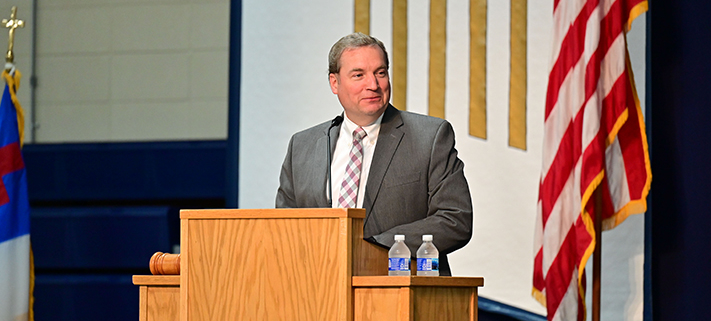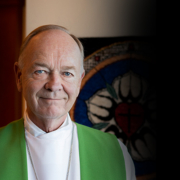Standing for the gospel
On Tuesday afternoon, Rev. Earle Treptow, president of Wisconsin Lutheran Seminary, Mequon, Wis., presented his convention essay titled, “Here We Stand: Imitating Luther’s Faith.”
Each synod convention, a pastor is invited to write and present an essay on the convention’s theme. “I considered it a great honor to be asked to serve as essayist. Since I could have quickly identified many who could have handled this assignment better than I, I also considered it a great privilege. While saying no to some opportunities to serve is necessary and wise, there are times when a person simply must say yes. This, for me, was one of those times,” reflects Treptow.
The essay walked delegates through the time in Luther’s life that led to his invitation to the Diet of Worms, his time in front of the dignitaries where he made his famous statement upon which the theme of this convention is based, and the aftermath of the stand he took facing the emperor—the stand he made for the gospel.
“Stories are powerful. And this story is particularly powerful for those who love the message of forgiveness full and free in Christ,” says Treptow. “Most Lutherans know what Luther said on April 18, 1521—at least the “Here I stand” portion—but they may not be as familiar with what led up to it and what followed after it. By telling the fuller story and sharing some details, I am hoping for a couple of things. First, I am hoping that people might be identifying lessons for their lives as Christians on their own as they hear the story and reflect on it. Second, I want to ground the lessons I identified in the story itself.”
Treptow then applied this chapter of Luther’s life to how Christians today should approach the gospel and the truth and blessing of God’s Word.
“I want to draw lessons from Luther’s appearance at the Diet of Worms that has application for us as individual Christians and as a synod,” explains Treptow. “Whenever I preach for Reformation or teach about Luther’s life, I remind myself: The hero of this story is the Lord of my salvation. Luther was an instrument in the Lord’s hand. The best instruments only produce good sound when talented musicians use them. You could put me at the bench of the most impressive grand piano ever produced and it wouldn’t sound very good at all. But a master musician can make an instrument sing. While I am not Luther and you are not Luther, the Lord can work in us and through us in ways that we cannot imagine. As the gospel of Christ dwells in us richly, the Lord strengthens us in faith and empowers us for service, just as he did with the Reformer. We imitate Luther’s faith in the Lord’s promises, confident that the Lord will enable us to stand firm and to be a blessing to others.”
To dive into the history as Treptow did required a lot of research and reading. “One of the nice things about being asked to serve in this way was that I got to do some reading and reflecting that I wouldn’t otherwise have done. I’ve been greatly blessed by the time I spent on the essay,” he says. “I committed to a lot of reading. All the while I was thinking about applications for life and ministry today. Once I had completed the reading I had time to do—there’s always more to be read—I outlined the essay. I specifically noted lessons I wanted to highlight and identified passages of Scripture that connect to those lessons.”
The essay illustrates Martin Luther’s passion for the gospel and notes that the same Lord who empowered Luther to confidently, yet humbly, profess his faith, continues to work in the hearts of believers today.
Treptow summarizes his main theme: “I want convention attendees to follow in Luther’s footsteps, in his passion for the gospel of Jesus Christ. His greatest concern was that the gospel be proclaimed clearly to all, so that consciences are comforted and God is glorified. Let’s stand for the gospel because the gospel has seized our hearts. . . . We proclaim God’s law for the sake of the gospel. Our desire is that all would know Jesus as their Savior.”
To download and read the essay or to watch the archived livestream of the presentation, visit wels.net/2021synodconvention.




